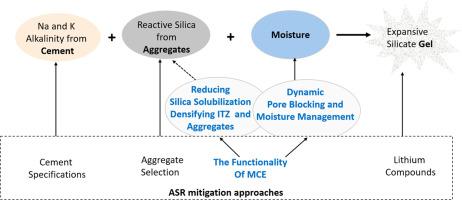Concrete deterioration by Alkali Silica Reactions (ASR) is a severe issue of concrete durability associated with porosity and permeability. Most of the industrial solutions for mitigating ASR rely on controlling the mix design by mineral admixtures or lithium compounds. An innovative approach for mitigating ASR through a secondary role of crystalline waterproofing materials is presented. An aqueous solution of Multi-Crystallization Enhancer (MCE) is intermixed with water or added to the concrete mixture, at a dosage of 2% by weight of cement, then upon curing reduces the permeability under pressure by more than 99%. This study shows that ASR mitigation can be accomplished by incorporating the MCE in the fresh concrete mixture or by prewetting the aggregates. The experiments were made according to the methods of ASTM C1260. The investigated independent experimental variables included water to cement ratio, types of aggregates, method of the MCE addition, and time. The MCE can change the performance of aggregates from reactive to be equivalent to non-reactive. The findings demonstrate that the length expansion from ASR increases with increasing the w/c ratio for all types of aggregates attributed to the increase in the permeability. The MCE addition to mixtures with reactive aggregates enhances the resistivity against ASR by a percentage in the range of 45%-77%. The functionality of the MCE in mitigating the ASR is also confirmed using concrete specimens with long term ASR testing (ASTM C1293).


